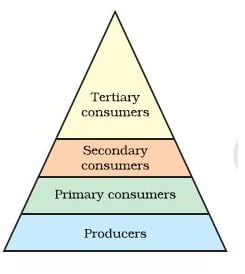Our Environment MCQ/Objective question Chapter 15 NCERT Class 10 Science
1. The interaction of components of the environment constitutes a:
- a. Ecosystem.
- b. Biome.
- c. Biosphere.
- d. None.
2. The components of an ecosystem is/are:
- a. Biotic
- b. Abiotic.
- c. Both.
- d. None.
3. Biotic components of an ecosystem include:
- a. All bacterium.
- b. All animals.
- c. All plants.
- d. All living organisms.
4. Abiotic components of an ecosystem include:
- a. Soil.
- b. Weather.
- c. Temperature.
- d. Every physical factor present in that ecosystem.
5. An ecosystem of an aquarium in the house is a:
- a. Natural.
- b. Human-made.
- c. None.
6. A pond ecosystem may be:
- a. Natural.
- b. Human-made.
- c. any of the above, depending on its creation.
7. Universal producer in an ecosystem is:
- a. Plant.
- b. Animal.
- c. Fungi.
- d. Algae.
8. Universal decomposer in an ecosystem is:
- a. Plant.
- b. Animal.
- c. Fungi.
- d. Algae.
9. Universal producer in an ecosystem is:
- a. Plant.
- b. Animal.
- c. Fungi.
- d. Algae.
10. A food chain is a series of interacting organisms in the ecosystem that depend on others for their nutrition. The organism in a food chain can be:
- a. Any organism that gets nutrition from others.
- b. Only animals.
- c. Only plants.
- d. Only humans.
11. Which among these may be an aquatic food chain :
- a. Small Fish » Big fish » Bear.
- b. Aquatic plant » fish» Bigger fish » Shark.
- c. Plant » cow » Lion.
- d. None.

12. Levels in a food chain make a :
- a. Food web.
- b. Trophic level.
- c. Food level.
- d. None.
13. Ultimate source of energy in an ecosystem is:
- a. Plants.
- b. Animals.
- c. Human.
- d. The Sun.
14. Animals get their nutrition from plants or other animals, which eventually thrives on the plant. So, the plant is a:
- a. Primary consumer
- b. Primary producer.
- c. Both.
- d. None.
15. Which among these can be a primary consumer:
- a. Humans
- b. Lion.
- c. Snakes.
- d. Cow.
16. Human is a _ _ _ consumer.
- a. Top
- b. Bottom.
- c. Middle level.
- d. None.
17. Plants trap what percentage of energy provided by the sun?
- a. 1%.
- b. 2%.
- c. 10%.
- d. 50%.
18. Only around _ _ _ % energy of a trophic level is available to the next trophic level.
- a. 1%.
- b. 2%.
- c. 10%.
- d. 50%.
- a. Multiple food chains.
- b. Food web.
- c. Food net.
- d. Food network.
20. The flow of energy in an ecosystem is:
- a. Sunlight » Herbivore » Producer » Carnivore.
- b. Sunlight » Producer » Herbivore » Carnivore.
- c. Sunlight » Carnivore » Producer » Herbivore.
- d. Sunlight » Herbivore » Carnivore » Producer.
21. A top carnivore among these is:
- a. Hen eating worms.
- b. Cat preying hen.
- c. Lion killing deer.
- d. A mongoose preying a snake.
22. Which light in the upper atmosphere produces oxygen free radical which make the ozone layer:
- a. Infrared.
- b. Ultraviolet rays.
- c. Blue light.
- d. Red light.
23. Synthetic chemicals like breaks the ozone molecule. Which among these are CFC?
- a. Chloro-fluoro-carbon (CFC)
- b. Methane.
- c. Petroleum products.
- d. All.
How do Organisms Reproduce MCQ?
Chemical Reactions and Equations MCQ.
Answer:
| 1.a | 11.b | 21.c |
| 2.c | 12.b | 22.b |
| 3.d | 13.d | 23.a |
| 4.d | 14.a | |
| 5.b | 15.d | |
| 6.c | 16.a | |
| 7.a | 17.a | |
| 8.c | 18.c | |
| 9.a | 19.b | |
| 10.a | 20.c |
Ref: Chapter 15, NCERT.
Our Environment MCQ/Objective question Chapter 15 NCERT Class 10 Science